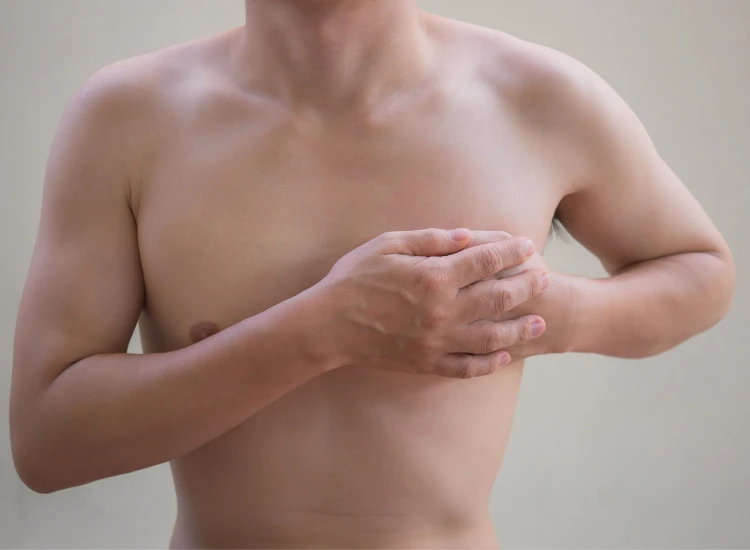Breast enlargement may occur in men due to hormonal changes, other disorders or medications used.

The enlargement of breast tissue in men is called gynecomastia and is an extremely common condition. Breast enlargement may occur in men due to hormonal changes, other disorders or medications used. Male type breast enlargement can occur on one side or on both sides. Gynecomastia occurs frequently in three parts of life, especially after birth, adolescence and old age.
The levels of estradiol and progesterone secreted by the mother during pregnancy immediately after birth are quite high, and these hormones ensure the development of breast tissue. After a while, gynecomastia disappears spontaneously. During puberty, it may occur once again due to changes in hormones. Today, approximately 60% of 14-year-old men have gynecomastia. Most of them are bilateral. However, it can sometimes be asymmetrically unilateral.
Another period in which gynecomastia is frequently seen is old age or the period over 65 years of age. Although it is not clear why it is seen in this process, it is thought that increased body fat and a more sedentary lifestyle cause male-pattern breast enlargement in old age.
Many factors that disrupt the hormonal balance in men can cause male-pattern breast enlargement, and most of the time, the exact reason for this situation cannot be found. However, changes in the body during puberty or aging can also cause a condition called gynecomastia.
Diseases affecting the testicles where the testosterone hormone is produced, problems affecting the thyroid gland, the gland that regulates growth and sexual development, tumors in the adrenal glands, pituitary glands or lungs, obesity that causes more estrogen secretion, some drugs, kidney failure or liver disorders can also cause male type breast can cause growth.
Male-pattern breast enlargement can occur as a result of a disease or due to the use of certain medications. Drugs used in the treatment of prostate cancer, anabolic steroids, HIV drugs, anxiety drugs, various heart disease drugs, some drugs used on an empty stomach, ulcer drugs, some antibiotics and tricyclic antidepressants are among the drugs that can cause male-pattern breast enlargement.
Physical examination is essential for the diagnosis of gynecomastia. In addition, the patient's past disease history and drug information are also obtained. Urine testing is preferred along with blood test, liver function test and hormone studies to rule out other ailments or diseases. In some cases, it may be necessary to take a sample from the breast tissue. This method is used when cancer is suspected.
Gynecomastia is divided into three according to its content as fluorine type, fibrous type and intermediate type. These types are usually differentiated by how long the growth in breast tissue has been present. Fluoride type is usually the initial stage of gynecomastia. It shows the changes that occur approximately in the first four months. In this type, ductal tissue and vascularity increase.
Breast tissue and adipose tissue are in varying proportions. The intermediate type is a one-year process and this process is accepted as the transition from fibrous type to fluoride type. Fluoride type has stromal fibrosis, which is considered as tight connective tissue in the breast. Ductal tissue is few in number. It is usually seen when the breast tissue begins to develop for more than one year.
In many cases, male pattern breast enlargement does not need any treatment and disappears on its own over time. However, in cases that occur due to hypogonadism, cirrhosis or malnutrition, the condition causing this condition should be treated. In cases that occur as a result of drug use, discontinuing the use of drugs or using equivalent drugs can make gynecomastia disappear.
When there is no reason other than hormonal change in adolescents, process follow-up is performed instead of treatment. Growth is monitored by re-evaluation approximately every three or six months. Gynecomastia usually disappears spontaneously within two or three years. However, in cases where it does not heal on its own, causes pain or pain or disturbs the person emotionally, it can be removed with gynecomastia operation. Surgical intervention is also used in cases where both growth and sagging skin tissue are excessive, such as stage 4 gynecomastia.
The best treatment method in the treatment of gynecomastia is the method planned according to the person. Because these processes are not alternatives to each other. Liposuction is applied when breast enlargement occurs as a result of excessive lubrication of the breast area. However, when gynecomastia occurs due to excessive growth of the breast tissue, the overgrown breast tissue is taken out of the body by mastectomy. Therefore, it is not possible to say that one of the operations is better than the other. However, if liposuction can be preferred, it is possible to talk about the effect of the devices and technique used.